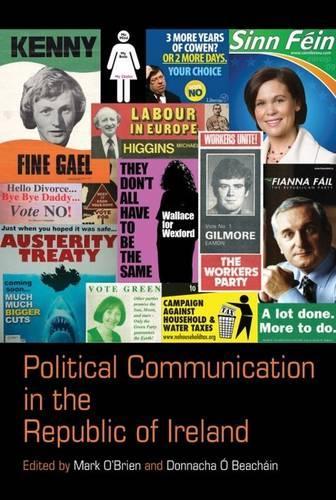
Political Communication in the Republic of Ireland
Series:
This book presents an overview of political communication in the Republic of Ireland from a multiplicity of perspectives and sources. It brings together academics and practitioners to examine the development and current shape of political communication in modern Ireland. It also examines what the future holds for political communication in an increasingly gatekeeper-free media landscape. The fiel
NaN
VOLUME
English
Paperback

This book presents an overview of political communication in the Republic of Ireland from a multiplicity of perspectives and sources. It brings together academics and practitioners to examine the development and current shape of political communication in modern Ireland. It also examines what the future holds for political communication in an increasingly gatekeeper-free media landscape. The field of political communication, where journalists, public relations professionals and politicians intersect and interact, has always been a highly contested one fuelled by suspicion, mutual dependence and fraught relationships. While politicians need the media they remain highly suspicious of journalists. While journalists remain wary of politicians, they need access to them for information. For most of the time, what emerges is a relatively stable relationship of mutual dependence with the boundaries policed by public relation professions. However, every so often, in times of political crisis or upheaval, this relationship gives way to a near free-for-all. Politicians, spokespersons and sometimes even journalists, become fair game in the battle for public accountability and support. The determination of public relations professions to avoid this and keep the relationship based on mutual dependence has become a central component of modern statecraft and systems of governance. The need to keep politicians and the media ‘on message’ and use the media to inform, shape and manage public discourse has become central to the workings of government, opposition and interest groups. On the other hand, the packaging of politics has potentially troublesome implications for the democratic process. In the era of the instant news cycle, new technologies and constant opinion polling, just where does information end and misinformation begin? With millions being spent annually on advisors and ‘spin-doctors’, just where does media access end and media manipulation begin?Table of Contents: PART ONE: POLITICAL COMMUNICATION AND POLITICIANS 1. Farrel Corcoran - Political communication: an overview 2. Donnacha Ó Beacháin - Elections and political communication 3. Sarah Kavanagh - A pragmatic partnership? Politicians and local media 4. Bryce Evans - Political communication and the ‘loony left’ PART TWO: POLITICAL COMMUNICATION AND JOURNALISM 5. Mark O’Brien - ‘Sources say . . .’ Political journalism since 1921 6. Mark Byrne - In sickness and in health: politics, spin and the media 7. Tom Clonan - Media advisors and programme managers 8. Declan Fahy - A limited focus? Journalism, politics and the Celtic Tiger PART THREE: POLITICAL COMMUNICATION AND THE PUBLIC 9. Gary Murphy - A private affair? Lobbying and transparency in modern Ireland 10. Colum Kenny - Equal Time for Judas Iscariot? Broadcast treatment of political contests in the Republic of Ireland 11. Kevin Rafter - ‘There now follows . . .’ The role of the party political broadcast and the 2007 ‘peace broadcast’ 12. Martin Molony - Social Media and political communication 13. Eoin O’Malley et al - Mediating elections in Ireland: evidence from the 2011 general election Conclusion Bibliography Index
Price Comparison [India]
In This Series
Bestseller Manga
Trending NEWS




















